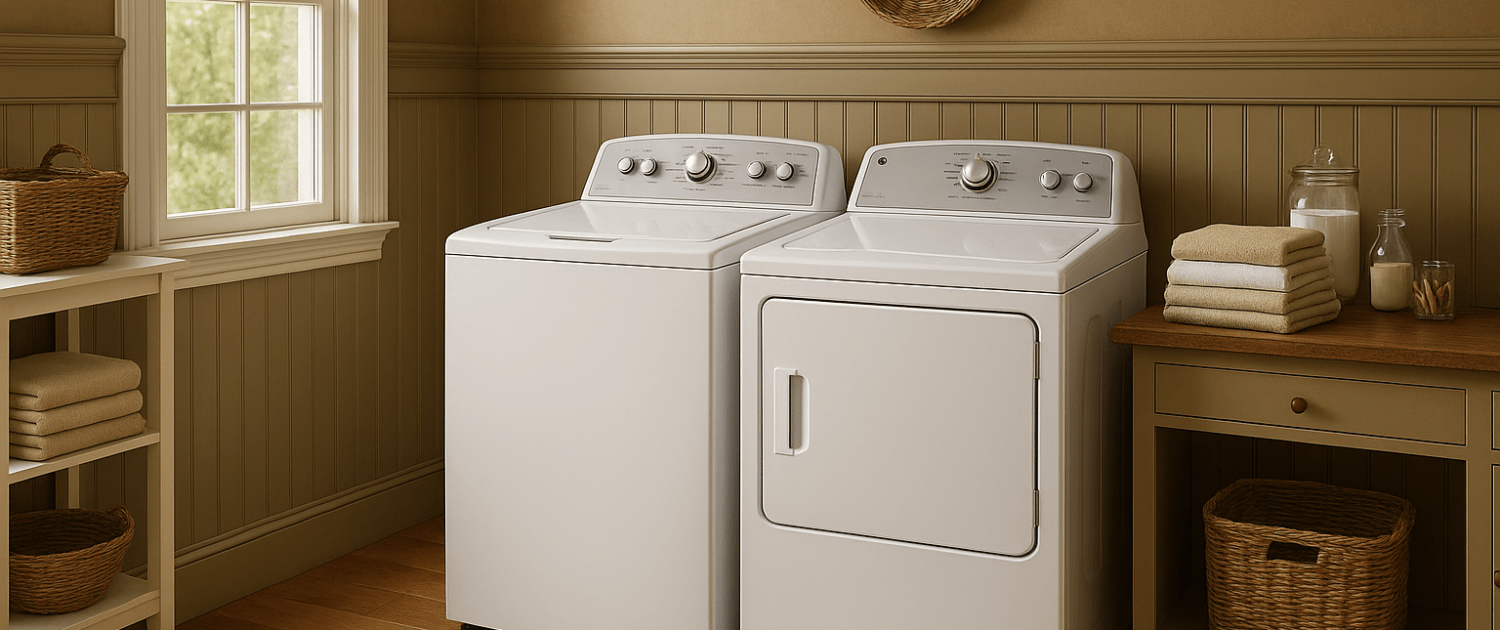DIY Testing and Replacing the Lid Switch on a GE Washer
Steven E / Friday June 6, 2025
A GE top-load washer that won’t start or suddenly stops mid-cycle can be frustrating. The culprit? A worn-out lid switch. This tiny part signals the washer when the lid is closed, and if it fails, the machine won’t run. Whether your model is gas or electric, we’ll guide you through testing and replacing the switch, no repairman is needed!
If you need any replacement parts for your GE washer, you can enter your model number at AppliancePartsPros.com to order them. Most orders arrive in just two business days, and we have thousands of free guides to show you how to install your new parts.
The information in this article may not apply to your specific appliance model. We recommend consulting your manufacturer’s documentation or contact us with any questions.
What you need
- 1/4 inch nut driver
- Small flathead screwdriver
- Phillips screwdriver
- Putty knife
- Tape
- Lanyard
Safety tips
When working on any appliance, remember to keep safety first. Here are some tips to keep in mind:
- Always power off and unplug your appliance or switch off the circuit breaker before you attempt any maintenance or replacement work. This keeps you safe by eliminating any risk of electric shock.
- If the appliance has recently been used, give it plenty of time to cool down before working on it.
- Take your time while working to prevent accidents and personal injuries. Rushing is the enemy of precision.
- Work in a well-lit area so you can see and access appliance parts.
- Keep your workspace free of clutter and other obstacles. Keep children and pets away from the work area.
- Never work on internal parts with wet hands. Make sure the work area is completely dry.
- Check the user manual to see if there are specific installation or safety instructions related to your appliance or replacement part.
- Be gentle when handling or removing parts. Excessive force might damage the appliance or cause personal injury.
- Wear insulated work gloves to protect your hands from sharp metal parts and debris.
- When working with wires, avoid touching any exposed wires or terminals. If you need to touch a wire, use a non-conductive tool or wear insulating gloves to prevent electrical shock.
- Always take photos or make a note of wiring terminals or other connections before disconnecting them to make reassembly easier.
- Don’t test live voltage with a multimeter if you’re unfamiliar with how to prevent short-circuiting.
- Consider wearing safety glasses and/or a dust mask when working with chemicals, dust or a large amount of debris to prevent irritation or injury.
- Turn off the water supply at the outlet before beginning repairs. Keep towels ready to catch any residual water in the system when removing parts.
How to test and replace the GE top load washer’s lid switch
Step 1. Access the lid switch
- Unplug the washer before starting any work.
- Remove the access panel by going to the back of the washer and using a 1/4-inch nut driver to remove the screws.
- Slide the access panel to the right to release the tabs and set it aside.
- Pull back on the control console to unlock it and rotate it over to access the control board.
- Locate the lid switch wiring harness labeled J513 on the board and press the locking tab to unplug it.
Step 2. Test the lid switch
- Set the multimeter to continuity mode.
- Test continuity between the red and blue wires by inserting a test lead into each wire. If there is continuity, the switch is working. If there is no continuity, the switch is faulty and needs replacement.
- Set the multimeter to Ohms mode.
- Test the lid switch lock solenoid by inserting a test lead into the white and blue wires. With the lid closed, the reading should be between 60-110 Ohms. If the reading is outside this range, the lock solenoid is faulty, and the lid switch must be replaced.
NOTE: Generally, for every 1 degree in temperature difference, 2 Ohms could be added or subtracted. If the temperature in your home is cooler, resistance would be subtracted.
Step 3. Remove the lid switch
- Follow the wire harness along the washer cabinet top and unclip the holder securing it.
- Use a small flathead screwdriver to push the two additional clips through.
- Rotate the control console back into place by aligning the tabs and pushing forward to lock it in.
- Use a 1/4-inch nut driver to secure the console with one screw.
- Open the washer lid and locate the strike at the bottom of the lid.
- Use a Phillips screwdriver to remove the screws securing the strike and set it aside.
- Use a putty knife to release the two locking tabs holding the washer top down.
- Press in on the locking tabs while pulling up on the washer top to prevent it from locking back in.
- Lift the washer top-up so the lid switch is accessible.
- Locate the two locking tabs on the bezel and bend them outward to release the bezel from the switch.
- Lower the washer top back down and remove the bezel.
- Locate the locking tab securing the lid switch and use a small flathead screwdriver to press it and slide the switch over to release it.
- Close the washer lid and tape it down to prevent it from falling when lifting the top.
- Lift the washer top carefully and lean it against the wall using a towel or lanyard for support.
- Pull the lid switch out from the two metal holders securing it and remove it from the washer.
Step 4. Install the new lid switch
- Align the new lid switch with the opening in the washer top and slide it into place to lock it in.
- Use a small flathead screwdriver to bend out the metal clips and secure the wiring.
- Press the two plastic locking clips into the washer top to secure the wiring harness.
- Feed the wire harness through the hole at the top and clip it in the last holder.
- Unhook the lanyard and lower the washer top until it locks into the tabs.
- Remove the tape from the lid and lift it up to reinstall the bezel.
- Align the bezel using the locating pin and lock it into place.
- Install the new strike by aligning it with the lid and securing it with a Phillips screwdriver.
- Close the washer lid and move to the back of the washer.
Step 5. Reassemble the washer
- Use the 1/4-inch nut driver to remove the screw holding the console and pull it back on the console.
- Rotate the console over and rest it on top of the washer.
- Run the wire harness along the washer frame and plug it into J513 on the control board, making sure it locks in place.
- Rotate the console back into position, align the tabs, and push forward to lock it in.
- Reinstall the access panel by aligning the locking tabs, sliding it to the left, and securing it with the 1/4-inch nut driver.
- Plug the washer back in.
- Run a test cycle to check if the lid switch is working.
- Verify that the lid locks and unlocks properly and confirm the washer completes a full cycle.
Looking for more?
We appreciate you dropping by! Hopefully this guide made it easy to test and replace the lid switch in your GE top load washer. If you’re still in need of any parts, head over to AppliancePartsPros.com with your model number. Our inventory of over two million parts and quick shipping means that you should get an exact replacement on your doorstep in just a few days.
Got questions? We have answers! Give us a call at 1 (877) 477-7278 or start a chat with one of our customer service team members online. In the meantime, you can explore our DIY blog and check out our videos on YouTube. And don’t forget to follow us on Facebook, X and Instagram so you don’t miss out on our latest and greatest!
With nearly a decade of experience in providing top-notch customer service regarding appliance parts and repair, Steven enjoys sharing practical advice, troubleshooting tips, and interesting information to help readers stay informed.





